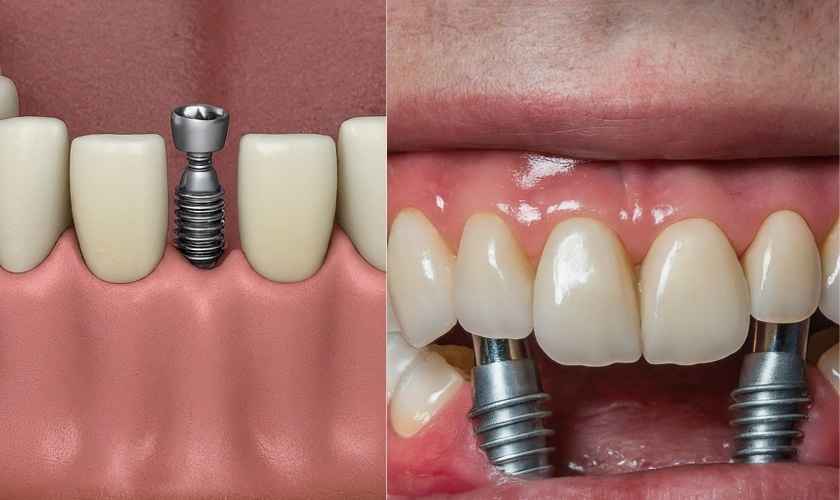The Of Dental Sense
The Of Dental Sense
Blog Article
Dental Sense - Questions
Table of ContentsThe Ultimate Guide To Dental SenseExcitement About Dental SenseThe Of Dental SenseIndicators on Dental Sense You Should Know
are clinical devices surgically implanted right into the jaw to bring back a person's ability to eat or their look. They offer support for artificial (fake) teeth, such as crowns, bridges, or dentures. When a tooth is lost due to injury or condition, an individual can experience difficulties such as fast bone loss, faulty speech, or adjustments to chewing patterns that cause discomfort.Dental dental implant systems contain an oral implant body and oral implant abutment and might likewise include an abutment fixation screw. Cosmetic dentistry services. The dental implant body is surgically inserted in the jawbone instead of the tooth's origin. The oral implant joint is generally affixed to the dental implant body by the joint addiction screw and extends via gums into the mouth to sustain the connected man-made teeth
(https://trello.com/w/dentalsense11/members)Framework of The Dental Implant System selecting dental implants, talk with your oral provider regarding the possible advantages and threats, and whether you are a candidate for the procedure. Things to think about: Your total wellness is a crucial consider establishing whether you are an excellent candidate for dental implants, just how long it will certainly take to heal, and the length of time the dental implant might remain in area.
Smoking cigarettes may impact the healing procedure and reduce the lasting success of the implant. The recovery procedure for the dental implant body might take several months or longer, throughout which time you usually have a temporary abutment instead of the tooth. the dental implant treatment: Very carefully comply with the dental health guidelines offered to you by your dental copyright.
The Basic Principles Of Dental Sense
Implant failing can lead to the demand for one more surgery to take care of or replace the dental implant system. Recovers the ability to chew Restores aesthetic appearance Aids maintain the jawbone from diminishing due to bone loss Preserves the wellness of the bordering bone and periodontals Assists keep adjacent (nearby) teeth stable Improves quality of life Damages to surrounding all-natural teeth during implant placement Injury to the surrounding cells during surgical treatment, such as sinus opening Injury during surgery (for instance, crack of surrounding jawbone) Poor feature, such as seeming like the teeth do not bite with each other normally An experience that the tooth is loosened or twisting in position arising from a joint screw loosening up Implant body failing (looseness of the dental implant body) as a result of systemic infection, which may be much more likely in individuals with uncontrolled diabetes because of neighborhood infection in bone and gums supporting the implant body because of delayed healing, which might be most likely in people that smoke Trouble cleaning the gum tissues around the dental implant, resulting in inadequate oral hygiene Untreated periodontal disease Post-surgical tingling due to nerve impingement or damages Constantly inform healthcare companies and imaging service technicians that you have oral implants prior to any type of magnetic resonance imaging (MRI) or x-ray procedures.
FDA is not knowledgeable about any type of adverse occasions reported for MRI or x-ray treatments with dental implants. Oral implants systems are usually constructed from materials that comply with worldwide consensus criteria of the International Company for Standardization (ISO) or ASTM International. These criteria have information of what makes a risk-free product.

A dental implant is a framework that changes a missing out on tooth. With screw-like tools, the doctor inserts a dental implant into the jawbone, and it works as a support for an artificial tooth, called a crown. A gadget called a joint connects the artificial tooth to the dental implant. The crown is tailor-made to fit the person's mouth and match the color of their teeth.
The Single Strategy To Use For Dental Sense
Some people are not qualified for dental implant surgical treatment. It is for dental surgeons to operate individuals with: severe illnessuncontrollable metabolic diseasebone or soft cells condition or infectionIf these concerns are settled, an individual can have the surgery. In, oral specialists avoid running on individuals with: If people with any one of the above go through dental implant surgery, there is a higher risk of the implant falling short.

Dental implant surgery is a personalized procedure. It's not the same for everyone. The adhering to provides a basic introduction of what find this you can anticipate your dental practitioner, dental specialist, periodontist or prosthodontist to do: Put the dental implant surgically. Offer you time to heal. Connect the message and final crown, bridge or denture.
Next off, your doctor will carefully position the dental implant into your jaw. Your cosmetic surgeon will certainly rearrange your gums and shut the incision with stitches. If your implant is near the front of your mouth, your dental expert will make a short-term tooth for you to wear till you recover. By doing this, you won't have a space in your smile while you recuperate.
The Best Guide To Dental Sense
During the recovery stage, your jawbone should fuse to the oral implant. This procedure can take anywhere from three to nine months.
Once your implant heals, your dental professional can affix the joint (tiny port article) and your last reconstruction (crown, bridge or denture). This usually takes regarding one hour to finish and might require a 2nd small surgery. You should not feel any discomfort during your dental implant procedure due to the fact that your service provider will certainly use drug to numb your periodontals.
Report this page